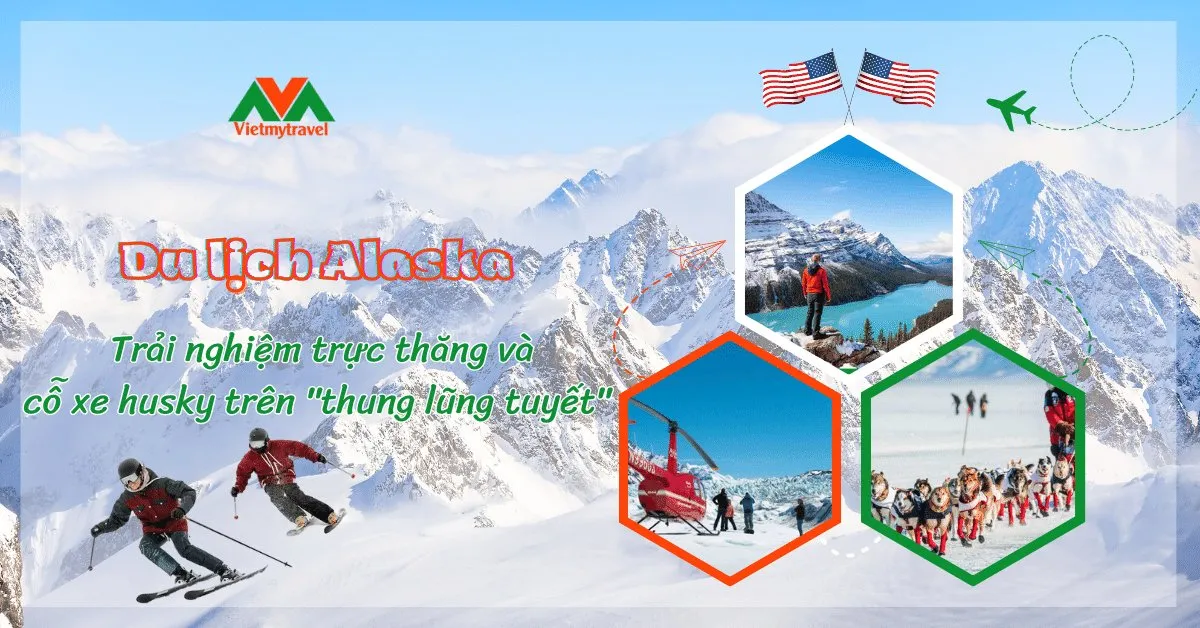Alaska blizzards aren’t just weather phenomena; they’re harsh tests for anyone venturing into this land. With terrifying destructive power, a blizzard can turn stunning natural landscapes into dangerous crushing machines, posing a direct threat to human life. Whether you’re a daring explorer, an adventure travel enthusiast, or simply someone wanting to discover Alaska’s wild beauty in winter, equipping yourself with Alaska blizzard survival experience is crucial. This article shares the essential knowledge and skills to help you cope with and overcome intense blizzards, ensuring safety for yourself and your companions.
Understanding Alaska Blizzards: The “Whiteout Fury”
An Alaska blizzard, often referred to as a “whiteout,” is an extreme weather event characterized by a combination of strong winds, heavy snowfall, and low temperatures. These conditions create an incredibly hazardous environment where visibility is severely limited, direction is lost, and movement becomes extremely difficult.
Causes and Characteristics of Blizzards
Blizzards in Alaska typically form when cold air from the Arctic flows south and meets moist air from the Pacific Ocean. This interaction creates powerful weather systems carrying large amounts of snow and strong gusting winds.
Key characteristics of Alaska blizzards:
- Heavy Snowfall: Snow accumulation can reach several feet in a short period, obstructing transportation and isolating communities.
- Strong Winds: Winds can exceed 35 mph (56 km/h), and even surpass 55 mph (89 km/h) in major storms, creating a rapid wind chill effect and a high risk of hypothermia.
- Extremely Poor Visibility: Wind-blown snow reduces visibility to less than a quarter mile (400m), sometimes just a few feet or even zero, causing disorientation and danger during travel.
- Low Temperatures: Temperatures frequently drop below freezing, combined with strong winds, increasing the risk of hypothermia and frostbite.
The Dangers of Blizzards
Alaska blizzards not only cause daily inconveniences but also pose numerous life-threatening risks:
- Disorientation: Poor visibility and the whiteout environment make navigation extremely difficult, easily leading to getting lost, especially in Alaska’s wilderness terrain.
- Hypothermia: Low temperatures and wind chill can cause the body to lose heat rapidly, leading to hypothermia, a dangerous condition that can be fatal if not treated promptly.
- Frostbite: Prolonged exposure to cold temperatures can cause frostbite to body parts, especially fingers, toes, ears, and nose, leading to permanent damage.
- Becoming Stranded: Heavy snow and strong winds can trap you in vehicles, tents, or isolated structures, cutting off supplies and communication.
- Traffic Accidents: Slippery roads, poor visibility, and heavy snow cover increase the risk of traffic accidents, particularly when traveling by car or other vehicles.

Thorough Preparation: The Foundation for Survival
Prevention is always better than cure. To minimize risks and increase survival chances in an Alaska blizzard, thorough preparation before facing a dangerous situation is paramount.
Monitor Weather Forecasts
Before undertaking any outdoor activity in Alaska during winter, always check the weather forecast carefully. Reliable weather sources provide detailed information on the likelihood of blizzards, wind strength, expected snowfall, and temperatures. If a blizzard warning is issued, postpone or cancel your plans and seek safe shelter.
Equip Yourself Fully with Survival Gear
A comprehensive and appropriate survival kit is an indispensable companion in Alaska’s harsh environment. Here is a list of essential items you need to prepare:
- Warm Clothing:
- Thermal underwear: The base layer helps retain warmth and wick away moisture.
- Down jacket or insulated jacket: The mid-layer provides primary insulation, keeping your body warm.
- Windproof, waterproof outer shell: The outer layer protects against cold wind and wet snow.
- Spare clothing: Always carry an extra set of warm, dry clothes in case your current layers get wet.
- Gloves and Headwear:
- Warm, waterproof gloves or mittens (spare pair recommended).
- Wool hat or balaclava that fully covers the ears and head.
- Scarf or neck gaiter (Buff) to protect the face and neck.
- Footwear:
- Insulated, waterproof snow boots with good traction.
- Thermal socks (spare pair recommended).
- Shelter:
- Four-season tent (if planning to camp).
- Insulated sleeping pad.
- Cold-weather rated sleeping bag.
- Heat and Light Sources:
- Waterproof matches or lighter.
- Flashlight or headlamp (with spare batteries).
- Candles or a small emergency stove for heat and cooking (use with caution in ventilated areas).
- Food and Water:
- Dry, high-energy food (instant meals, chocolate, nuts, jerky…).
- Bottled water or a thermos with hot liquid.
- Water purification tablets (in case you need to use natural water sources).
- Medical Supplies:
- Personal first-aid kit (bandages, antiseptic wipes, pain relievers, personal medications…).
- Sunscreen and lip balm/moisturizer (to protect skin from dry air and windburn).
- Navigation and Communication Tools:
- Compass and map of the area.
- GPS device (if available and you know how to use it).
- Satellite phone or emergency communication device (Personal Locator Beacon – PLB) if traveling in remote areas.
- Survival whistle.
- Signal mirror.
Plan Your Itinerary in Detail and Inform Others
Before starting your journey, create a detailed plan including your route, destination, estimated duration, and planned stops. Share this plan with family, friends, or authorities so they know your schedule and can assist in case of an emergency.
Survival Skills When Stranded in a Blizzard
Despite careful preparation, unexpected situations can still occur. If you unfortunately get stranded in an Alaska blizzard, the following survival skills will increase your chances of survival.
Find Safe Shelter
As soon as you notice signs of a blizzard or visibility starts to decrease, seek safe shelter immediately. Ideal shelters include:
- Vehicle: If traveling by car, park in a spot sheltered from the wind, away from trees and power lines. Ensure the exhaust pipe is clear of snow to prevent carbon monoxide (CO) poisoning.
- Tent: If you have a tent, set it up in a wind-sheltered location and secure it firmly to prevent it from being blown away.
- Snow Cave or Snow Trench: If no man-made shelter is available, you can dig a snow cave or trench to escape the wind and stay insulated.
- Abandoned Structures: Cabins, sheds, or other abandoned buildings can provide temporary shelter.
Stay Warm
Keeping your body warm is the top priority to prevent hypothermia. Take the following measures:
- Layer Clothing: Utilize all the clothing layers you have to trap heat.
- Keep Clothes Dry: Wet clothing causes body heat loss much faster. Change out of wet clothes into dry ones as soon as possible.
- Cover Body Completely: Cover your head, neck, face, and extremities to minimize heat loss.
- Light Exercise: Gentle movement helps generate body heat, but avoid strenuous activity that causes sweating.
- Warm Up with External Heat: Use a lighter, candles, or a small stove (in a well-ventilated space) to create heat.
- Huddle for Warmth: If with others, huddle together to share body heat.
Stay Alert and Positive
A positive attitude and strong willpower are crucial factors in overcoming hardship. Stay mentally alert, avoid panic, and maintain belief in your ability to survive.
Find Food and Water Sources
In a prolonged stranding situation, finding food and water is necessary to maintain health.
- Food: Prioritize consuming the food rations you brought. If supplies run out, you might search for natural food sources like berries (if identifiable and safe) or small animals (if you have hunting skills).
- Water: Melt snow to obtain drinking water. Avoid eating snow directly as it can lower your core body temperature. If a natural water source (stream, lake) is available, boil or purify the water before drinking.
Signal for Help
When weather conditions permit, try to signal for help to be rescued. Use the following methods:
- Survival Whistle: Blow the whistle repeatedly using the SOS pattern (three short blasts, three long blasts, three short blasts).
- Signal Mirror: Use a mirror to reflect sunlight towards aircraft or areas where people might be.
- Fire: Build a fire to create smoke and attract attention (exercise caution regarding fire safety and avoiding wildfires).
- Brightly Colored Materials: Use brightly colored clothing or fabric to create a visible signal against the white snow.

Conclusion: Surviving an Alaska Blizzard – A Test of Courage and Wisdom
Alaska blizzard survival experience involves more than just skills; it’s a combination of knowledge, thorough preparation, and the courage to face challenges. Alaska blizzards are an inseparable part of this land, possessing both wild beauty and destructive power. Understanding blizzards, preparing adequately, and equipping yourself with essential survival skills will help you safely explore Alaska’s unique beauty, even in the harshest weather conditions. Remember, survival comes not only from physical strength but also from intelligence, perseverance, and a positive spirit. May you have safe and memorable journeys in the challenging and captivating land of Alaska!